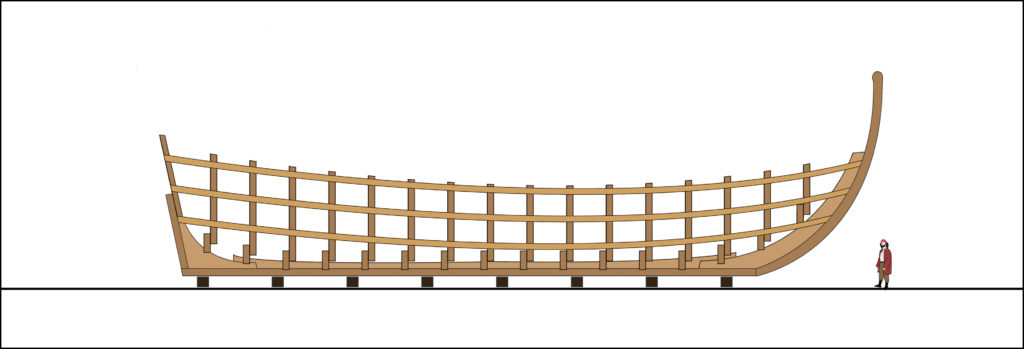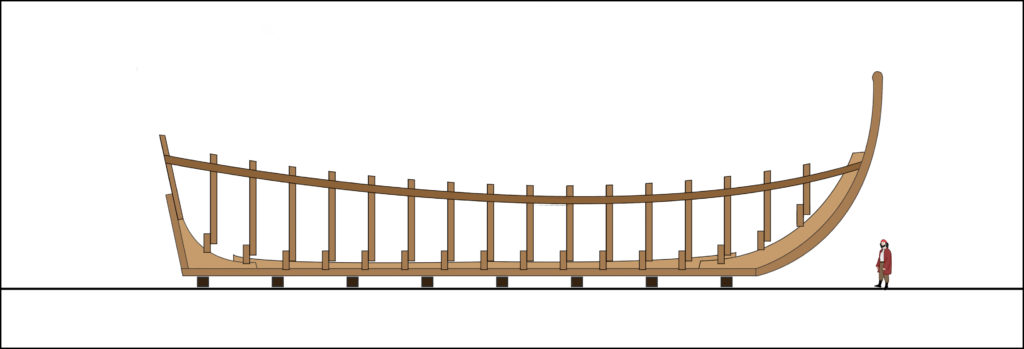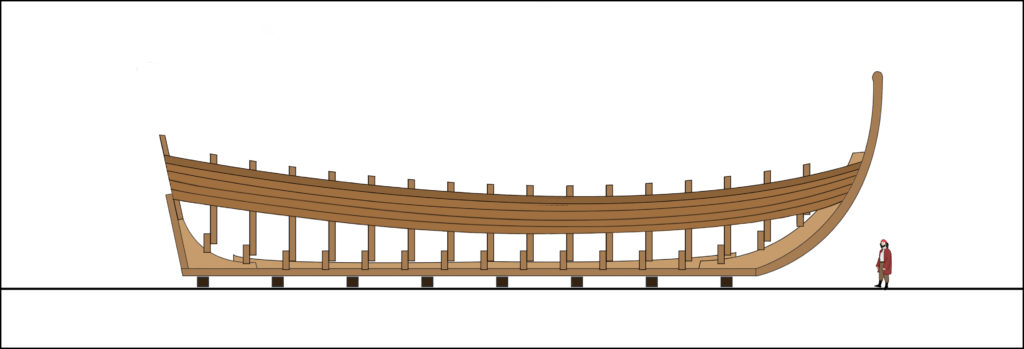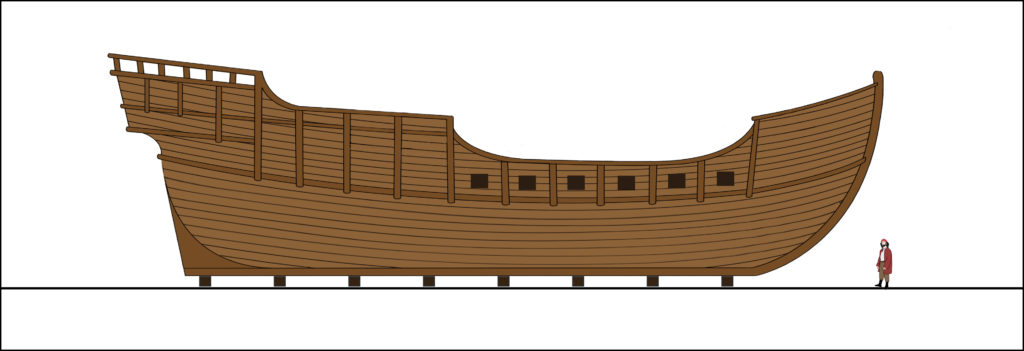(This post is a continuation of Shipbuilding in the Sixteenth & Seventeenth Centuries – Part 1. If you haven’t done so already, it’s best to read that post before continuing on here.)
So far, in looking at the process of building a sixteenth/seventeenth century sailing ship—a caravel—we’ve reached the stage where the keel, the sternpost, the stempost, some of the ribs (floors and futtocks), and the keelson are all in place. It looks like this:
Notice that not all the ribs have been attached yet. This is the stage where the shipbuilder needed to do some eyeballing.
If a ship is to sail well, it needs to have clean lines. That is, the hull needs to be smoothly and symmetrically curved along its full length. Any deviation from that smooth curve will detract from the ship’s sailing properties.
The first step to getting the lines of the hull as perfect as possible was to attach a series of “whales”—long flexible boards that were temporarily tacked onto the ribs. This enabled the shipwright to see if there were any gaps or irregularities in the placement of the ribs, and also enabled him to place the remaining ribs in proper position. You can see what it looked like, with all the ribs properly in place, in the illustration below:
Once the ribs had been carefully adjusted to form the most perfectly smooth hull shape possible, the temporary whales were removed and replaced by a new whale that formed part of the ship’s permanent structure. You can see that below:
To ensure that the ribs stayed in position, a pair of “stringers” was added. These were thick boards that ran the length of the hull, parallel with the keel, notched to fit over the floors to keep them from shifting about under the stresses of a sea voyage. You can see the stringers, the rib (floors and futtocks), the keel, and the whale, plus get a sense of the streamlined lines of the ship—a caravel, remember—in the illustration below. Unlike the other illustrations so far, this is a top view rather than a side view:
The skeleton of the hull was now fully in place. It functioned just like the skeleton of a living being, providing a rigid yet flexible support.
The next step was to cover the ribs with hull planking.
Creating these hull planks was no easy task. There were, remember, no powered machines back in the sixteenth and seventeenth centuries. Everything—everything—had to be done laboriously by hand.
When we think of wooden boards today, we think of 8-foot (2.4 meter) lengths maybe 6 inches (15 centimeters) wide and maybe an inch (2.5 centimeters) thick. The planks for a ship’s hull were larger than that, some of them way larger.
Trees were larger in those days. It takes a tree hundreds of years to reach an impressive height. Except for a few old growth forests still existing in national preserves or in the rare remaining stretches of genuinely wild and untouched jungle, the old trees on our planet are pretty much gone now, cut down for lumber long since. Four hundred years ago, though, there were still lots of old—huge—trees left. Finding a tree for a 65-foot keel was no issue at all back then. Finding equally large trees for the planks wasn’t either.
The planks for the ship’s hull were created in saw pits in the shipyard, one by one, from the trunks of large trees and then hauled over to where the skeleton of the ship lay.
A scaffolding was erected around the ship, and the hull planks were carefully lifted up and set in place. Fitting them required both muscle and skill, for they not only had to be bent into place around the curvature of the hull, they also had to be tapered so that they would fit together snugly at the stern and the bow. These planks were typically too large to be simply nailed into place. Instead, they were attached using “treenails.” A hole an inch or so in diameter was drilled though the plank and into the supporting rib behind it. A large wooden dowel was them hammered into the hole, holding the plank tight against the rib. The illustration below shows the first set of hull planks in place.
Slowly, the entire hull was sheathed. The superstructure for the upper decks was put into place, along with the decks themselves, and the upper part of the hull was planked. You can see how the finished ship looked below:
Notice how fundamentally simple the lines of a caravel were.
It really does look a bit like a large rowboat.
Caravels like this had four decks: a maindeck amidships (the lowest part of the ship in the middle), a foredeck (the higher part in the bow), a quarterdeck (just aft of the main deck), and a poopdeck (at the stern). The illustration below shows these decks as seen from above (the human figure is still there for scale, but the only way to position him to show scale makes it look as if he’s lying down):
The maindeck (where the human figure is) was the lowest (the closest to the water). To get to either the foredeck or the quarter deck from the main deck, you had to climb a steep set of stairs (ladders). To get to the poopdeck from the quarterdeck, you had to climb another set of stairs.
A caravel used as a merchant ship would likely have carried a cannon or two. A caravel used by corsairs, though, would have been more heavily armed—hence the cannon crowding the maindeck in the illustration. The ship’s cannons wouldn’t actually have been set in place on the deck until much later, after the construction process was fully complete, but it’s helpful to see them in position here.
So now the ship—the caravel—was almost finished.
Before the vessel could go into the water, though, the hull planks had to be calked.
No matter how carefully the hull planks might have been fitted, there were always small gaps between them through which water could seep. Caulking consisted of carefully hammering lengths of tar-impregnated hemp rope—known as “oakum”—into these gaps. Once all the gaps had been filled, the seams of oakum were covered with a further coating of tar, making everything watertight.
The ship was now ready to be floated on the water.
All shipyards were located on the shoreline of a river or the sea. Getting the newly constructed ship afloat simply meant nudging it carefully along a set of log rollers until it slid into the water.
Once the ship was afloat, the masts, spars, rigging, and sails could be installed. Caravels were quite simple when it came to sails. One type—the caravela latina—only had lateen (triangular) sails. A second type—the caravela rotunda—had a combination of lateen and square sails. The ship in the illustration below is a caravela rotunda. It is typical of its type, with one lateen sail on the mizzenmast (the mast at the stern of the ship), two square sails on the mainmamst, and one square sail on the foremast. The black horizontal line in the illustration represents the waterline. The ship depicted would have been is close to 90 feet (27 meters) long from stern rail to bow (the human figure is still there for scale, though now he appears to be walking on the water):
It was caravels of about this size that explorers like Christopher Columbus, Bartholomew Diaz, and Ferdinand Magellan sailed in.
And it was caravels of about this size that some Barbary corsairs (and pirates in general) like to sail in, too.
Caravels were simple, solid, reliable vessels, renowned for their maneuverability and seaworthiness. They were large enough to be intimidating, yet small enough to be fast and agile and to be able to navigate relatively shallow waters—very useful when trying to evade a larger foe like a full-sized warship or to put ashore raiding parties for a land attack.
Building a ship like a caravel was relatively simple—if you had to knowledge, the skill, and the manpower.
In the sixteenth and seventeenth centuries, people did.
They built vast numbers of caravels and other ships. There were—quite literally—thousands of these laboriously hand-built ships plying the seas of the world.
A testament to the ingenuity of the human mind and the dexterity and strength of the human hand.
 The Travels of Reverend Ólafur Egilsson
The Travels of Reverend Ólafur Egilsson
The story of the Barbary corsair raid on Iceland in 1627
Amazon listing







